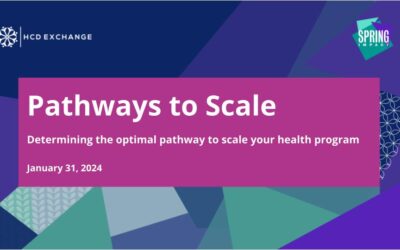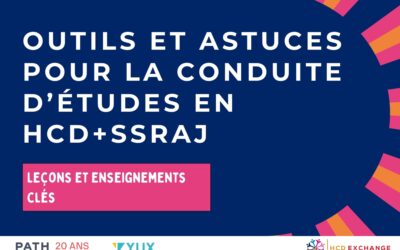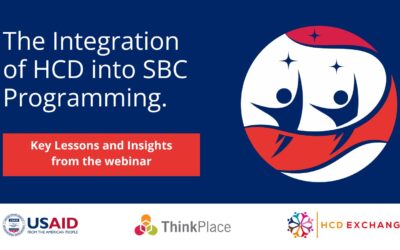One of the big thematic areas we are exploring at the HCDExchange in 2024 is HCD Insights. Insights from human-centered design (HCD) research form the basis for understanding the behaviors, needs, challenges, desires, and aspirations of program participants, and help to shape the design direction of health interventions and solutions. However, this term often gets misused and misunderstood. That is why we are running an event series on the power of HCD insights; to demystify these powerful learnings and help practitioners better craft and adopt insights in their work.
We hosted the first event in this series on February 28, 2024, in partnership with Quicksand, an India-based design studio. The purpose of this session was to help practitioners understand the difference between findings and insights, and how to craft insights from research findings to strengthen the design of health interventions. Quicksand took us behind the scenes of Amplifying Resilient Communities (Project ARC), a project that sought to understand the experiences of vulnerable populations interacting with healthcare systems during and after the COVID-19 pandemic in Bangladesh and South Africa, to help us learn from factors that contribute to health resilience in communities. Here is a summary of what was covered:
Design Research
Project ARC took an in-depth approach to HCD research, starting with a household survey, to lay the foundational understanding of health-seeker challenges. The project team then conducted the first round of design research, to dig into health-seeking practices, social relations, influencers, the notion of trust within the spaces where people were seeking care, and the impact of the pandemic. They then conducted video ethnography — a practice that records participants in their natural settings — to provide valuable socio-cultural context. The final round of design research delved deeper into the life histories and care journeys of health seekers with the aim of arriving at key friction points, and opportunities of change within the health system.
“This whole process took a little more than two years, and each of these rounds were at least 2-3 months long in the field, followed by analysis and synthesis, and figuring out what we needed to do in the next round. I wanted to call this out because, as practitioners, I’m sure many of you might have faced the challenge of having to do research in quick time periods, but also to emphasize the fact that HCD and design research ought to take its time when we are dealing with such complex contexts and problems.” Babitha George, Director at Quicksand.
Findings Vis-à-Vis Insights
Findings are what is observed; insights explain why it matters. In HCD research, findings are objective observations about a user’s behavior and preferences. Insights are a deeper understanding that reveals underlying motivations and opportunities for innovation.
The finding is what the research has revealed, and the insight is derived from peeling back layers of understanding, and asking ‘why?’ enough times to feel as though the underlying meaning has been discovered. Insight statements are then crafted as actionable hypotheses to inspire or shape the design of the intervention.
“An insight is really something that prompts you to action. It moves you towards thinking about how we could create a meaningful intervention, how we could think of innovations, etc. So that was really how we framed frictions.” Babitha George
The Quicksand team opted to use a manual process of thematic analysis to analyze their research, rather than a software. They used a collaborative virtual whiteboard to document their research findings, identify similarities, categorize them, and group, or ‘cluster’ them. In addition, they tracked notes from discussions which deepened their analysis and gave way to the crafting of insights.
Here’s an example on how the Project ARC team derived insights from research:
“We quickly began to notice that trusted communications were communications that were not one-way; they were dialogue-based communications. In Bangladesh, where we were working in really tightly-knit communities, people told us about previous outreach around [tuberculosis] and COVID-19 as well, and how they were engaged in dialogues. They told us about how they clarified their doubts, and about the dignity of being engaged in conversations instead of a one-way information dump — that really mattered to them, and that’s the information that they really trusted. We weren’t seeing this in South Africa. There was a lack of trusted communication. So from that, we extracted this insight, that dialogues are pathways to trust in health communications, and once there is trust, then people act. Therefore, dialogues are pathways to action and awareness, and health communication should ideally not be one-way.” Romit Raj, Principal at Quicksand.
The project team gleaned many such insights across their research and from this, they were able to draft a model they termed ‘Strands of Health.’ This model illustrates the many factors that make health-seekers’ perceptions around health, how they make decisions, and how they evaluate their own health status and that of their families. It goes beyond physical health and encompasses everything from emotional health through to spiritual and environmental health.
“Understanding motivation behind behavior is crucial for design, and this tool started to do that for us. So we started using the Strands as a tool to begin to untangle the health-seeking decisions we were seeing in our own data.” Romit Raj.
Using Insights in the Design Process
For Project ARC, the next step was to take these insights and create user journey maps. These mapped out the journey of a health-seeker and sought to explain why health-seekers and their families made the decisions they did at each point, based on different considerations across the ‘Strands of Health’. From there, another layer of insights was gleaned: the frictions that health-seekers were encountering.
These frictions represented the gaps between the expectations of the health seekers, and what health practitioners (public, private and traditional) were able and willing to provide. These can be seen as barriers, and they can also be seen as opportunities for intervention and innovation, which is what insights are at their core.
The Quicksand team took a pause to underscore the importance of understanding and expecting that the insight generation process will be messy and non-linear, and to embrace this as part of the process for arriving at strong insights.
“I think as much a part of insighting is being comfortable with that ambiguity as we’re making sense of things, to also live with the messiness, because the richness comes from that messiness.” Babitha George.
The Final Product
The goal of this project was to imagine more resilient, better, and more human-centered health systems. It was therefore important to develop clear pathways for health system actors to act on these insights. The Quicksand team conducted extensive reviews to ensure that they were aligned with health system objectives and the interventions that were already being led by health system actors, as well as with the individuals and communities who were navigating their health-seeking journeys in creative ways around existing frictions. This enabled them to identify guiding design principles for public health system actors and other stakeholders to act upon.
In addition, they created a set of prompts, or ‘creative springboards’, imagining how health systems might look if these insights were actioned — these can be found on the project website as an aspirational call-to-action.
A Template for Crafting Insights
How can you translate these learnings to your work? Here is a template with examples that you can use to start crafting insights from research findings:
- [User group] need a way to [user need] because [insight]
Example: Community members need a way to identify what is authentic because they don’t trust what people say about COVID-19 on social media.
- [User group] need a way to [user need] but [insight]
Example: Adolescent girls and young women need a way to feel safe in low-income urban areas but public spaces have no functional lights, which promotes illegal activities.
- [User group] need a way to [user need] surprisingly [insight]
Example: Adolescent girls and young women need a way to feel safe in low-income urban areas. Surprisingly well-lit places create a sense of safety.
We hope you have deepened your knowledge about the value and power of insights, and how they may be harnessed for your own public health work. Watch this space for the next insights session in May!



